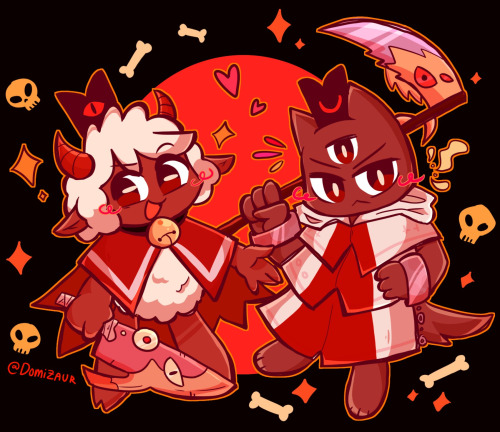Massive Monster - Tumblr Posts

How do you think they killed time?
Narinder's Veil - An Analysis
A quick overview.
With the addition of the Bishop's of the old faith DLC, it was reveals Narinder's robes are actual a uniform of sorts denoting him as a death god. And once the Lamb has rescued all the bishops, they receive a version of these robes in fleece form. This made me wonder if TOWW's veil had any deeper meaning?

What is a Veil?
"A veil is an article of clothing or hanging cloth that is intended to cover some part of the head or face, or an object of some significance."
TOWW wears a black veil that partially obscures his face. Similar ones can be seen on his attendants, Baal and Aym, and former members of his old cult, Klunko, Flinky, and Shrumy. They seemingly serve no pratical use as before initiating combat Aym and Baal rip the veils off, possibly for increased visibility and keep the stands out of their eyes. Because these veils are only seen worn by TOWW and those in association with him or his cult, I assume these veils are exclusive to him and the veils we see worn by others are derivatives of his.
After some research, I was able to find an irl veil that most resembled the one TOWW wears:
A Sehra
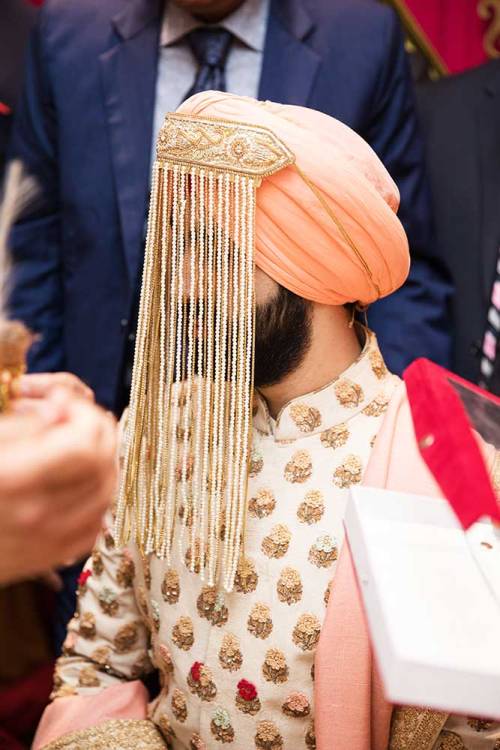
"In some parts of India, Pakistan, Bangladesh, and Nepal, men wear a sehra on their wedding day. This is a male veil covering the whole face and neck. The sehra is made from either flowers or beads."
Similar to veils worn by women, a sehra was worn to ward off the evil eye and to keep the bride and groom from seeing see each other before their wedding ceremony. While the reason for wearing the sehra is different, TOWW's veil very much resembles one.
Irl there are many cultural that require participants to adorn face veils or for sacred objects to be veiled. The most common practice that is familiar to most would be the wearing veils by brides on their wedding day. Interestingly the act of wearing a veil was prominently done by women and there are few cultures where men are expected to veil instead. In these cultrures, boys begin wearing veils after puberty and is considered a mark of manhood. It's interesting to note that everyone that wears a veil in COTL is male or male presenting.
Veils aren't always used for religious purposes.
Now that we have a better understanding of what veils are and why they are used let's move on to the next part of this analysis.
In-universe cultural meaning?
What could TOWW's veil mean to him and his servants?
Because all the information I've collected thus far, l'll break them down into seperate theories.
1.
As a mortal, Narinder died before or on his wedding day and was buried in his grooms clothes. Once he became a god, his wedding veil was one of the things he kept, either as a sentimental or cultural memento.
When the lamb usurps TOWW as death god, they don't recieve a veil, only his robes. This led me to assume TOWW veil is unique to him. For those that don't know, TOWW's name, Narinder, is of Indian origin. Because this and his face veil resembling a Sehra headdress, I like to image TOWW was originally from the COTL equivalent of India. Given how long TOWW has been a god, this place may no longer exist, with TOWW being the last 'living' member of this long lost culture. Only he would know the cultural meaning behind the veil. Others may have begun wearing them in association with TOWW.
11.
Given TOWW's station, being the patron of a cult and a literal god, it's plausible that his veil could be worn as a way of creating a barrier between himself and his followers. With the each number of strands denoting a rank amongst his servants. While Ratau's gang don't worship TOWW anymore, if at all given their dedication to Ratau, they may still wear the uniform of their ranks before the dissolution of TOWW's old cult.
"One view is that as a religious item, it is intended to honor a person, object or space. The actual sociocultural, psychological, and sociosexual functions of veils have not been studied extensively but most likely include the maintenance of social distance and the communication of social status and cultural identity."
The reason his servants are wearing them could be for a similar purpose. To seperate themselves from low level followers and layman. What is a cult if not a religion in it's infancy? Even still there seems to be a hierarchy amongst veiled servants of TOWW. Aym and Baal, likely due to their proximity to TOWW and having directly trained by him, have the most strands second only to TOWW himself. Ratau's gang each have different numbers of strands, possibly implying they were each at different level of their ordainment. Within TOWW's cult veiled members may have been the equivalent of enforcers
111.
TOWW's veil is a mourning veil of sorts.
"The mourning veil was commonly seen as a means of shielding the mourner and hiding her grief, and, on the contrary, seen by some women as a means of publicly expressing their emotions."
We don't know the deeper psychology behind what it takes to be a death god, to see hundred of thousands of millions of people die for all eternity. Granted TOWW seems quite psychopathic and is probably able to rationalize away his role as a death god, so maybe the veil is more for the souls that he reaps. A faux display of grief by an impersonal grim reaper. From a superstitious aspect, I'm sure looking directly into the face of death would be held as a very bad thing to do. TOWW also seems emotional constipated enough to wear something to show the emotions he won't let himself express.
A Deeper Look...
Something I noticed about the veils. Including TOWW, each character has a different number of strands/garlands:
Narinder = 22
Aym and Baal = 20
Klunko = 8
Flink = 6
Shrumy = 4
It's up to speculation as to why they each have a different number but that's what I'm here for. After a bit of searching I came to the realization that the amount of strands might correspond to the Major Arcana. While a pack contains 78 cards the first 22 are referred to as such and are considered more important than the rest. This is because they were meant to represent the spirtual journey through life. With that knowledge we can attribute each number of stands to a card in the Major Arcana:
Note the first card of the deck, The Fool, is not numbered.
If I match the number of veil strands to a card in the major arcana this is what we get:
Narinder (22) = The World (XXI)
Aym and Baal (20) = The Sun (XIX) or Judgment (XX)
Klunko (8) = Justice/Strength (VII/XI)
Flinky (6) = The Lovers (VI)
Shrumy (4) = The Emperor (IV)

The Arcana of the Lamb
Starting with TOWW, this what each correlation of veil strands to a card could mean.
Narinder The World (XXI)
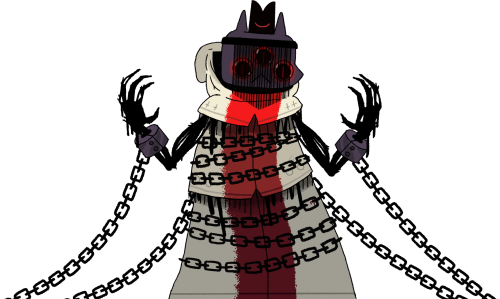
"THE WORLD - Assured success, recompense, voyage, route, emigration, flight, change of place.
Reversed: Inertia, fixity, stagnation, permanence."
The World card is said to represent the end of life. It makes sense that Narinder wears this number.
"The World represents an ending to a cycle of life, a pause in life before the next big cycle beginning with the fool."
The "nexus between what was and what was not" in TOWW's own words. It's says alot that the number of TOWW's veil strands corresponds with this card and not the literal death card (XIII). That could be because the death tarot does not actually represent death but change. Paradigm shifts, changes in beliefs and philosophies.
The reverse of this card also represents TOWW's situation. "Stagnation" & "permanence". As death, TOWW was a permanent fixture within the world of COTL. Even with his fascination with the new and novel, his siblings, or atleast Shamura, expected TOWW to remain unchanged and stagnant in his existence.
https://en.m.wikipedia.org/wiki/The_World_(tarot_card)
Aym and Baal The Sun (XIX) or Judgment (XX)
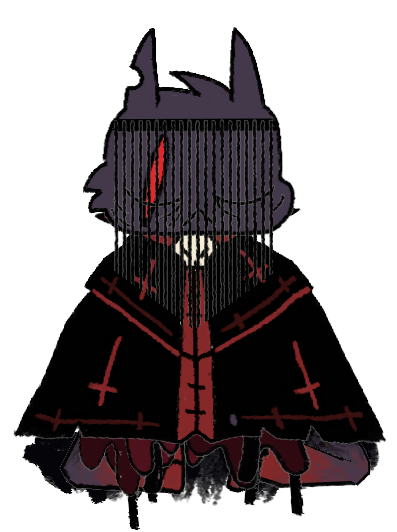
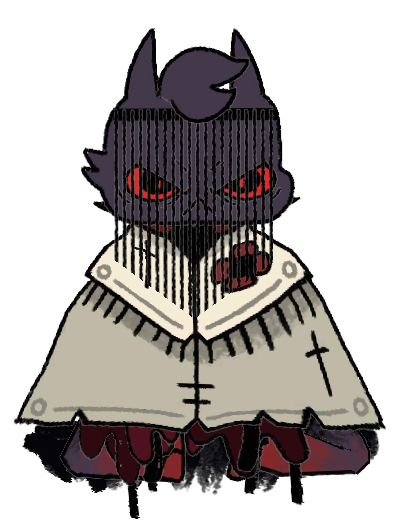
Judgment : self-evaluation, awakening, renewal, purpose, reflection, reckoning
Reversed: self-doubt, lack of self-awareness, failure to learn lessons, self-loathing
Per google, the word judgement has two definitions:
1. the ability to make considered decisions or come to sensible conclusions.
2. a misfortune or calamity viewed as a divine punishment.
It can be assumed that the meaning of their corresponding tarot is the second definition. Within the story of COTL, they are fought after declining to return the red crown. Their battle could be interpreted as divine punishment, as they say as much. Within the game, they act as the precursor to TOWW's battle. Their fight could be considered a test of sorts for the player, as many of their attacks are diminutive versions of their master's.
Or
"THE SUN - Material happiness, fortunate marriage, contentment.
Reversed: The same in a lesser sense."
Considering their fate within COTL's story, I doubt this is the real interpretation of the number they wear. It is the actual 20th card of the Major Arcana but it can be assumed the devs meant the technical 20th card, The Judgement. Granted, depending on the players, the two can be reunited with their mother which makes them happy and content, that was retroactively added in the DLC and might not have been something the devs originally meant to add.
Klunko (and Bop) Justice/Strength (VII/XI)
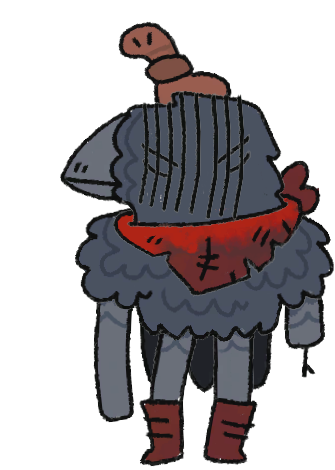
Within the major arcana, the order of the Justice/Strength is switched or changed depending on the deck. So I decided to give the meaning of both.
FORTITUDE - Power, energy, action, courage, magnanimity; also complete success and honours.
Reversed: Despotism, abuse of power, weakness, discord, sometimes even disgrace."
And
JUSTICE - Equity, rightness, probity, executive; triumph of the deserving side in law.
Reversed: Law in all its departments, legal complications, bigotry, bias, excessive severity."
Within the game, Klunko, and Bop by extension, will give The Lamb the Strength from Without Tarot Card if they beat them.
Flinky The Lovers (VI)
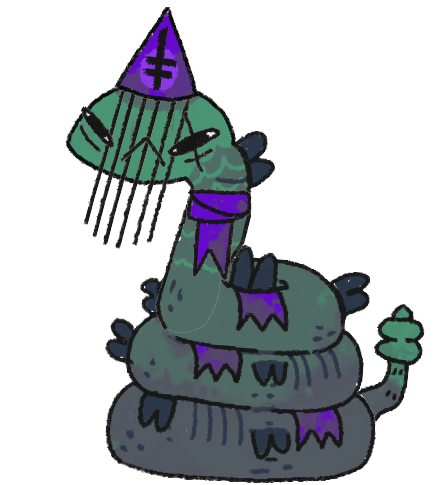
THE LOVERS - Attraction, love, beauty, trials overcome.
Reversed: Failure, foolish designs. Another account speaks of marriage frustration and contrarieties of all kinds.
"In some traditions, the Lovers represent relationships and choices. Its appearance in a spread indicates some decision about an existing relationship, a temptation of the heart, or a choice of potential partners. Often an aspect of the Querent's life will have to be sacrificed; a bachelor(ette)'s lifestyle may be sacrificed and a relationship gained (or vice versa), or one potential partner may be chosen while another is turned down. Whatever the choice, it should not be made lightly, as the ramifications will be lasting."
While the numbers may align, I personally don't feel the card really applies to Flinky, unless the devs are implying some hidden relationship between Flinky and another character. This card better suits Ratau and Ratoo, given they give the in-game version of the Lovers card. They could also be twins, the Lovers cards us also associated with the star sign Gemini, known as the Twins. But I digress..
But Flinky's number of veil strands corresponding to the lovers card could have more to do with the imagery depicted on the Lover's card:
"In the Rider Waite deck, the imagery for this card is changed significantly from the traditional depiction. Instead of a couple receiving a blessing from a noble or cleric, the Rider–Waite deck depicts Adam and Eve in the Garden of Eden. By reducing the number of human beings depicted in the card from three to two, Waite was able to reinforce its correspondence with Gemini. The Rider–Waite card also includes the Tree of the knowledge of good and evil with a serpent wrapped around its trunk. The symbolism of no return from making bad decisions, and the consequences of innocence lost, would be more widely understood from this imagery."
Flinky could be an homage to the serpent that tempted Eve to eat the apple of Eden. Maybe his consul is what influenced Ratau that leaving their old cult was an option.
Shrumy The Emperor (IV)
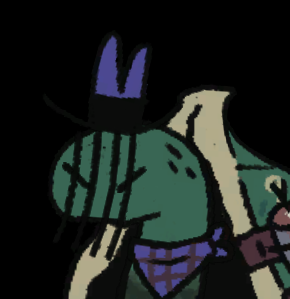
UPRIGHT: Authority, establishment, structure, a father figure
REVERSED: Domination, excessive control, lack of discipline, inflexibility
"The Emperor sits on a ram-adorned throne, a symbol of Mars. Another ram head can be seen on his cloak. His long white beard bears the symbol of "wisdom". He holds an Ankh scepter in his right hand, and a globe, symbol of domination, in his left. The Emperor sits atop a stark, barren mountain, a sign of "sterility of regulation, and unyielding power." He symbolizes the top of the secular hierarchy, the ultimate male ego. The Emperor is the absolute ruler of the world."
"In Astrology, the Emperor is associated with the masculine, cardinal-fire sign of Aries, the domicile sign of Mars which is symbolized by the ram."
Shrumy behavior toward the Lamb fits alot with this card, in my opinion. When they first meet he's quick to assert his dominance as a non-follower of the lamb. Shrumy also makes it clear that he has no care or respect for crown bearers, as the power they wielded seemed to change them.
"What are you looking at? Hmf. That's right. You crown bearers are all the same. Nothing without your adoring Followers. Ratau wasn't like that. He stayed true to who he was. You'll NEVER live up to him. Get out of my way, I've got Knucklebones to play and money to win. Come and play me if you want a real challenge."
- Shrumy to the Lamb
Shrumy falls more into the reversed position of this card. But I did notice a striking similarity to the Emperor Tarot and TOWW's role within the plot of COTL.
"The Emperor is the absolute ruler of the world."
Whatever TOWW'S gospel was the end result of killing his siblings would have made him the only god remaining and the De facto ruler.
After millennia, all may bask in my glory once more.
"Vessel, do you not worship me? Do you not give offerings in hopes of gaining my favor?
Soon I shall be freed, and the world remade in my image. All will pledge themselves to the Cult. All will bow to my name."
The words of a man(cat?) with enough ego to choke a horse lol. While not explicitly stated to be Baal and Aym's father TOWW does fill a father figure role to them. Having essentially raised and mentored them. Similar to Ratau's relationship with the Lamb, TOWW could also be considered a father/mentor to the Lamb too.

Conclusion
Initally I was only going to include the tarot card bit, but I couldn't keep my love of anthropology at bay so I added some cultural theories too.
I'm entirely sure the inclusion of these characters wearing veils doesn't actually mean anything but I'm just zooted off my gourd on caffeine so I'm gonna theorize anyway lol. Either way I had fun researching info for this rabbit hole I dug and I hope anyone who actually takes time to read this enjoys it too.
Some Narinder character analysis for y’all.
This is a slightly re-edited excerpt from a much longer post of mine where I was specifically trying to provide a rebuttal to someone else. I’m kinda proud of some of my takes here and the write up took me hours so I’m gonna repost it here on its own.
I’m going into specifically into Narinder’s
Speech patterns and way of expressing emotions.
Implications of his post defeat dialogue
Relationship with Aym and Baal
Feelings on Ratau’s death
And a little extra on why do we “babygirl” Narinder
Full analysis under the cut.
The way Narinder expresses his positive feelings
First I gotta establish Narinder’s voice. Narinder seems almost incapable of giving a genuine compliment especially without turning it into something about himself.
Here’s three examples of him giving a complement to The Lamb. Taken from after defeating Amdusias and Shamura. He also complements The Lamb when you sacrifice Ratau but I’ll come back around to that.



I wanted to grab the entire quotes so it didn’t look like I was nitpicking.
"Very good, my vessel. It seems I chose well when I kept you from Death.”
First example, “very good,” is the complement, but immediately after he takes credit for this by calling you “my vessel” thereby claiming ownership over you. His vessel did well. And again “I chose well” doubled down and complemented himself.
“I admit, you have worn it (the red crown) almost as well as I could have myself.”
Again we see the complement layered in ego. “Almost as well as I” in other words you did well, but don’t forget I’m better. Also important to draw attention to is “I admit” this is a very explicit statement of his refusal to acknowledge the success of others.
"Your appetite for death is something I can admire, Vessel. But the Crown is mine, and none - NONE - are worthy. None other than I.”
Here he almost lays down a complement. “Your appetite for death is something I can admire” straight up, states his admiration. He seems to almost realize what he’s done and quickly pulls back into his ego, “But the crown is mine” “-none are worthy- None other than I.”
These are the three of the four ONLY times that Narinder ever says anything explicitly positive about someone else when he is a god. Thus establishing that the head ass cannot give out a compliment to save his life. The one time he gives you full credit for your actions he immediately pulls right back into his ego.
I cannot stress this enough. Someone who is characterized as cold and emotionally closed off as Narinder is WILL NOT suddenly undo this characteristic when they try and express a positive feeling.
Okay with that established we can look at his follower dialogue. Specifically these two examples from when you resurrect a follower and allow him to go on a mission.


“I cannot begrudge supplantation by one such as yourself.”
Literally saying I don’t resent you for taking my place. It’s not an explicit statement that he respects you but this is he weird fucked up little way of saying it. Of course he still lays it out in a way that’s self centred but we know from the way he has spoken that this is about as much verbal praise he is capable of giving.
The other one is a less explicit statement but I think it’s a interesting reflection of the final place of his character.
“…my thanks, Lamb.”
Being his last bit of unique dialogue, it’s an incredible ending to a character. He thanks you. That’s all he needed to say.
Narinder’s reaction to his defeat that he would rather die.
Let’s go over his dialogue in some depth.

"You weak, snivelling, foul thing. You - wait! Waaaiiiiiit!"
I’m starting with this line as it compels me the most. I find that there are two separate readings of this and I can’t really point to one above the other. On my play through I had assumed his wailing was more in reference to being denied death. It could also be read as him not wanting to be reduced to a follower and realizing what your mercy really means for his future.
“-are you to be a vengeful false idol, or a merciful coward? No longer can you blame your vile acts on me."
Okay, looking at the way he presents your two options he seems to push more for the murder action. “-vengeful false idol,” is how he refers to murder. It’s not exactly a glowing review but his use of the word vengeful is important. We know that one of Narinder’s main goals in the game is revenge, we he already acts with revenge I can’t say that he’s using this word as an insult. The false idol part of this statement seems like he’s attempted to separate himself from you, again for is ego.
Then he presents the spare option by calling you a “merciful coward.” The flow of this full sentence puts more pressure on this option. He presents it as the “or” the second option. This is the bad option, the option of a coward.
“So. vou are no different to me after all. You have become as I am."
I know this is a deranged order to go over these quotes but last we got murder. Compared to his spare dialogue this is incredibly sombre. We know from already establishing how big his ego is that saying you are the same as him is almost a compliment. I do find this dialogue incredibly interesting tho, I can’t exactly explain why but I can’t help but read this as damning as well. It’s like he means it in both ways, the ultimate fuck you. You are just as I am, for better and worse.
But from what we know about Narinder his edgy ass cannot express emotion. He wraps his statements in layers of irony and selfishness. Unless it supports the persona he puts on or inflates his ego he WILL NOT right out state his feelings or needs, especially when he was a chained god.
Relationship with Aym and Baal
Aym and Baal are incredibly hard to characterize. They don’t have much dialogue to work off of and only three characters every speak on them, Shamura, Narinder and Forneus. The context of the game does present them as more Narinder’s first (and second) hand, less followers more apprentices, almost, but where’s the fun in assuming.



"Intended as keepers, perhaps, but they were young and in need of guidance. Must I be blamed for my influence?"
I wanna draw attention to the specific wording of keepers. Again, based on the way Narinder speaks its safe to assume he means the formal meaning of a keeper, meaning a caretaker. It is unclear if Narinder was told they where his keepers or if he assumed so, but either way he still speaks on them as such.
For the sake of argument (and I don’t wanna rewrite this bit entirely) I’m gonna put the idea that Narinder brainwashed Aym and Baal against my presented idea of them being his keepers or apprentices.
The proposed idea of the brainwashing angle can be developed based on Narinder saying that “they where young and in need of guidance, must I be blamed for my influence.” This implies that, as much as Aym and Baal may have been sent as keepers, they where still young and Narinder could not help but be an influence on them. I am gonna come back around to this thread so hold onto this for a moment. Moving on.
“Two kits I did have, true love found! And yet one lackadaisy summer day, my beautiful children were taken away... a gift, they said, for the one they loved most, the one that waits...”
“Ooh, kits... I remember, I remember... two kits in my claws... a gift.."
It is unclear and morally dubious how Aym and Baal came to Narinder. First we’re not 100% where Narinder is chained. The wiki lists it as the afterlife and in dialogue Narinder refers to it as “at the gates between this life and the next, trapped at the nexus of what was and what wasn't.” (When he asks you to send him on a mission.) We can travel there both by dying and being summoned there by him.
Either way the assumption is that Aym and Baal had to die. (As an aside I have my own speculation on the conditions required for a person to be presented to Narinder or to be resurrected but that’s off topic.) The horrific implications being that either Shamura themself killed the kits or that they where already dying. However you cannot blame the reaper for ushering the dead away from life.
I’m going to work off of the cult specific definition and characteristics of brainwashing. It’s hard to characterize where Aym and Baal sit here as, again they have little dialogue and due to the nature of brainwashing it’s hard to spot. First I wanna grab my brainwashing resources.
I’m using Encyclopedia Britannica’s page on brainwashing, cults, indoctrination, manipulation as my primary resourse.
Again I kinda wanna apply a layer of irony to how literally I apply real life tragedy to this game that obviously uses cults in a comedic manner. I wanna focus in on the characteristics displayed by victims of brainwashing and the techniques used in brainwashing by an abuser.
Looking at the elements used in brainwashing the only one I can say off the bat that is present is isolation, obviously. But with that let’s grab all of Aym and Baal’s dialogue.




What is clear from their dialogue is their obedience to Narinder. They call him master while his keepers and still when you meet them later when adventuring. And physically we do see them by Narinder’s side the entire main game and they fight the Lamb first. But if we add some nuance and look at their role as keepers or my own theory of being apprentices both actions of obedience make sense still for those roles. On the same note they also don’t display traits you would expect for someone fully under Narinder’s control. They speak to the Lamb out of turn and attack without prompting from Narinder.
Other characteristics are hard to imply. With torture I do want to pass it off an unlikely as based on the way Narinder tries to manipulate the Lamb it’s only verbal and he cannot attack while chained and I don’t see that changing with the keepers. Traits like sleep, water and food deprivation can’t be applied for various reasons (mostly the being dead one) and we don’t know anything about Narinder and the keeper’s interactions in the past so I’ll have to disregard other traits like suggestion.
Baal: "It's you. Usurper of the Red Crown. The one who freed us."
Aym: "Ha! You are nothing compared to our Master. We have not been in this world long, but already I can tell you are weak. You lack discipline. Our Master wielded Death with precision and control. You allow chaos to reign."
Baal: "What my brother means to say is thank you."
Moving onto groupthink I can pretty comfortably say that this is not a present characteristic of Aym and Baal. In their limited dialogue we can easily characterize Aym as more outwardly defensive of Narinder but Baal is more reserved and even contradicts Aym and is able to speak freely of Narinder.
Looping back around to the way Narinder speaks on his influence on Aym and Baal. Again we know how Narinder speaks, he cannot give honest compliments and dodges affection like it’s a professional sport. With the way he will outright tell the Lamb to manipulate followers and then uses the words “guidance” and “influence” about Aym and Baal, he has to be avoiding admitting affection to the keepers. He does follow that up with “Do what you wish, scornful God. I care not for them.” But again does Forneus not also allow her kits to do as they wish?
My own reading of Narinder’s relation to Aym and Baal is that of mentorship but it could also be read as parental. But saying brainwashed is a big stretch.
His feelings on the death of Ratau

This is like another example of like, yeah, wow, an evil character does evil? Who could’ve possibly foreseen this? Sarcasm aside I do see his comments on this being a lesser evil.
First I do have to ask why, if Narinder held strong sense of unrest against his former vessel, did he not have him struck down? The main reason I can see is that Ratau is still devoted to the red crown, most clearly seen by the statue at the lonely shack which generates devotion.
Second, Ratau’s death isn’t on his hands, it’s on yours. I find his pride here is from The Lamb’s actions not the death of Ratau. You killed your mentor, he describes your actions as “treacherous opportunism” and says “A great Vessel takes their master's will as their own.” Based on his later dialogue this is likely more foreshadowing the Lamb becoming as Narinder is. Narinder tried to kill his siblings, and you did kill your mentor. “You have become as I am."
I’m gonna tangent quickly cause there’s a line here that is incredibly interesting.
"He renounced his position after striking a bargain that resulted in the sacrifice of a Follower. He was weak."
Incredibly interesting the way he condemns Ratau’s sacrifice of a follower. Narinder directly contradicts himself. It is implied that the follower was lost to another being that did not benefit Narinder, but the Lamb also sacrifices followers to the Fox and Midas. Just something to chew on.
Why do we “babygirl” Narinder and other evil characters?
This is kinda the last bit I’m gonna get into before I cap this off. It is incredibly funny for me to say “I babygirl Narinder” only to get a reply that’s like “I don’t think you babygirl him on purpose.” But I wanna talk about why this happens and why it happened to specifically Narinder.
When people complain about the fandom interpretation of Narinder I think they forget the tone of cult of the lamb. The closest thing I could think to call it would be a dark comedy kinda energy.
The game has very dark themes going on. Mentions of real horrible things like genocide, cults and religious abuse. But also just like look at the game, it’s visual style is so cute and non threatening, the bird characters have two mouths to commit to the bit. If you look at the way it depicts cults it’s very surface level, it’s more focused on being a satire on the common satanic media kinda look of a cult. Visually it bathes in its aesthetics, taking names from books like The Lessee Key of Solomon, uses villainous depictions of symbols like the pentagram or old Hebrew script, disregarding its nuanced origins.
And then they go onto do the funniest thing ever. The other bishop’s? Gross little freaks, based on commonly disliked animals, worm, frog, squid and spider. And then- and then they make the god of death, who they characterize and manipulative and evil, they make him a catboy. You cannot tell me they did not know what they where doing.
Why have I shot Narinder with the babygirl beam? CAUSE THE GAME DID IT FIRST!
I’m gonna call the god of death my little meow meow and point out his status as a Tumblr sexy man cause he’s a little guy and I wanna give him head scritches. But I’m also gonna call him a layered, fucked up and an incredibly interesting character in the same breath.
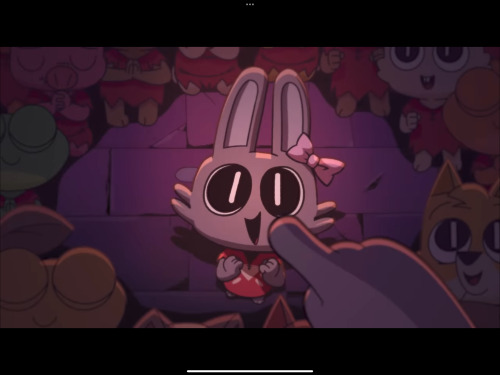
Wait. Is that…

NANA?!?
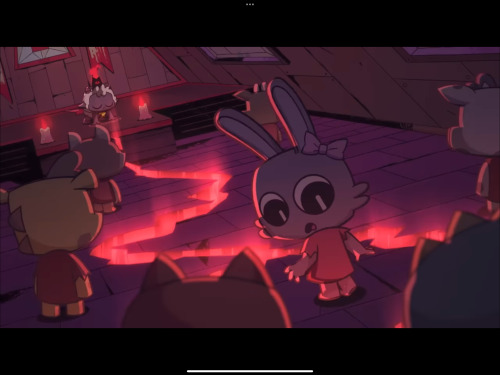
Oh
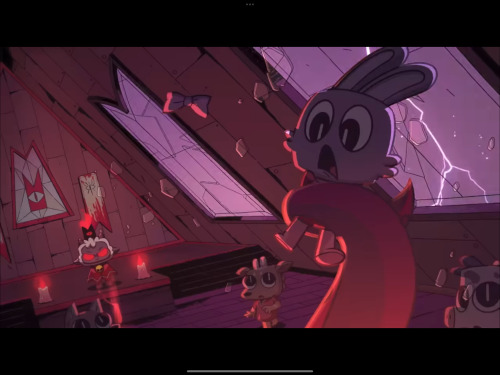
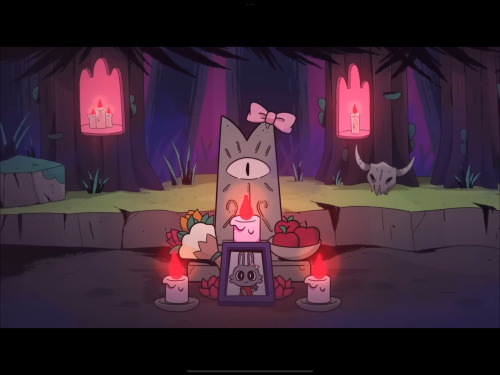
Oh no.

OH NO!
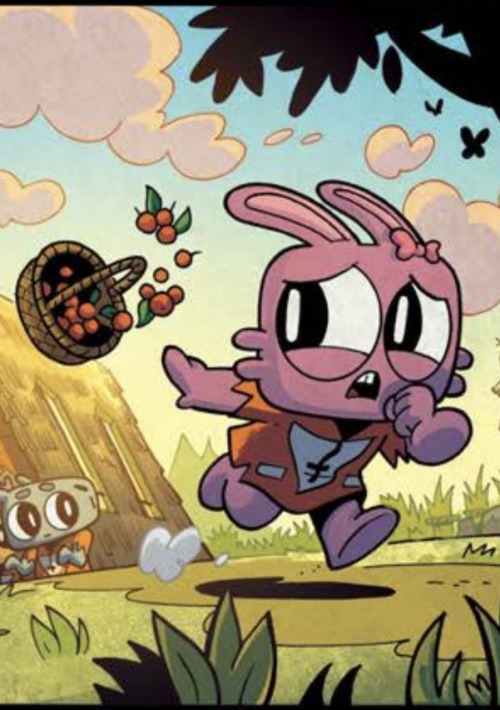
RUN NANA, RUN BEFORE IT'S TOO LATE!

This is a new CotL tarot card that apparently shows Goat’s version of The One Who Waits/Narinder. As you can see, he’s a white cat with a purple crown. Or at least that’s how it seems. The card is called Renegade Victorious. Its description reads: Those vanquished in this life shall triumph in the next.
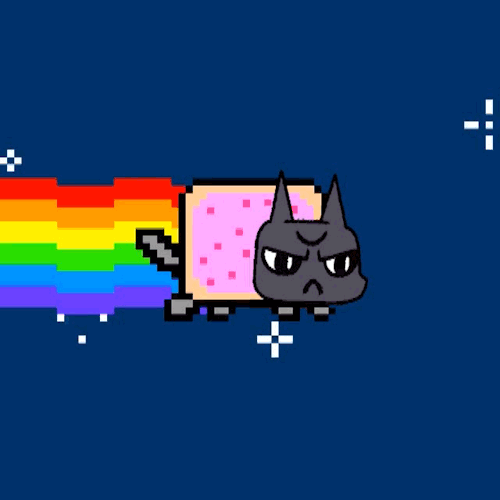
At the request of @rainy-intel, I present to you Nyarinder Cat
No I'm not sorry
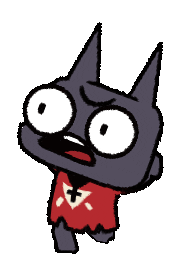
Scardy Cat

That floating ring was sewn...!?
Xの方のフォロワさんが浮き輪が皮やと言うてはって、気が付いた。
か、皮やんお前…!!
So my friend and I made an au that had Narinder as a ferryman for souls and I wanted to draw it.

They bring Lamb along sometimes and they just love to watch the souls float around in the deep, dark waters.
Also I hate drawing and coloring chains with a passion, idk why I keep doing it to myself. But it looks good so ¯\_(ツ)_/¯

lamb girl

Hehehe @bamsara get attacked!
First attack of the year! Lets see if I'll have the time for more then three attacks this time lol

I demand more baal and aym
So sorry you're gonna be the victim of my random thoughts now

I like to think that Baal and Aym do have their own things to do but from time to time they like to help those close to death to pass on peacefully, not just because they used to help a lot with TOWW but because they somehow make the followers feel even more reassured about their demise and what awaits for them (even if Aym and Baal themselves don't know what it is that awaits)
-💊

I'm practicing drawing the lamb, so I've chosen Kori as my victim. They are just too pretty, I couldn't resist (ノ∇≦*)
this specimen of a lamb belongs to @xmajordumps (I wanted to show how much I appreciate your work, so here is a lil gift! I hope you like it)

death kitty (real)










mix of some established narilamb doodles




IT'S ALMOST OCTOBER SO YOU KNOW WHAT THAT MEANS!
There's just one rule: have fun!
As you can see I created three levels of difficulty but don't feel pressured to stick with one the whole October
You can use #cotltober so your art will be easier to find

Slugcat of the Day #284
and last and also least, the One Who Waits
♡ ♡
If you're able, make a donation to Walaa's fundraiser to help her and her family of ten flee Gaza, where they can find safety and she can continue her many years of study to become a doctor. Their campaign has been vetted by el-shab-hussein and is more than halfway to their goal, but donations have slowed down.

